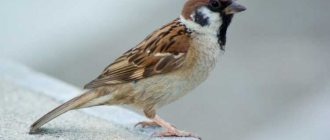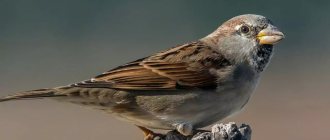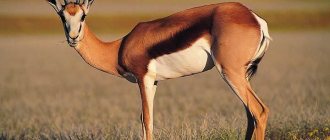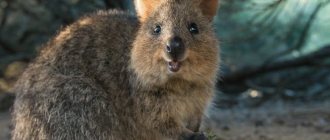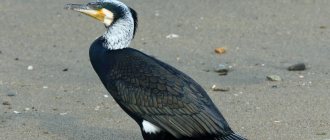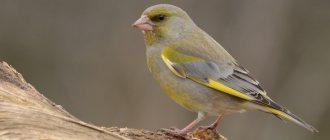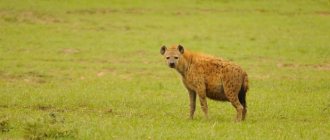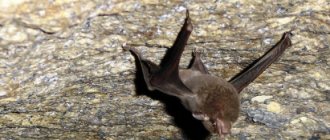- Wild animals
- >>
- Birds
The sparrow is a bird that every person has met.
This small bird has become an indispensable attribute of the trees growing in the yard, a herald of approaching warm days and impending rainy weather. Where the feeders hang, the ringing hubbub of sparrows is constantly heard, and with the approach of spring, their cheerful chirping can be heard everywhere. Little sparrows have become heroes of fairy tales, stories, sayings, nursery rhymes, proverbs and even folk superstitions. Let's take a closer look at the life activity of this small, but nimble and very famous bird.
Origin of the species and description
Photo: Sparrow
The sparrow is a widespread bird from the passerine family of the same name.
It is said that the thievish nature of the sparrow gave this bird its name. This happened at the moment when the feathered stole a bun from the baker, and he shouted after him: “Beat the thief!” This is how the sparrow got its name.
Ornithologists identify about 22 species of these birds, eight of them live nearby; the most commonly found species of sparrows are:
- brownie;
- field;
- black-breasted;
- stone;
- red;
- snowy;
- short-toed;
- Mongolian earthen.
The appearance of a sparrow is familiar to almost everyone from childhood. This is a small bird, but its beak is quite massive. The colors of the sparrow are dominated by gray, light brown and dark brown tones. Each sparrow species has its own distinctive features, some of which we will describe.
Video: Sparrow
The black-breasted sparrow has a chestnut head, neck, wings and back of the head. Light motley spots are observed in the area of the back. The sides and cheeks of the sparrow are painted in light colors. The craw, throat, and half of the breast are painted black. The wings are lined with a horizontal dark stripe. Males look much more elegant and brighter than females.
The snow sparrow (finch) is decorated with long black-and-white wings and a gray tail with lighter feathers along the edge. A black spot stands out noticeably in the throat area of this sparrow.
The stone sparrow is quite large compared to its relatives; the distinctive feature of this bird is a wide light stripe running along the crown, and its beak is light brown. The chest and throat are light-colored with speckles, the crop is decorated with a spot of bright lemon color.
The red sparrow has a rich chestnut color, the back of the head, back and wings of this particular shade. The female is distinguished by a light gray or brownish breast.
The short-fingered sparrow is very small, the color of its feathers is sandy, narrow small stripes of light color can be seen on the throat and end of the tail.
The Mongolian ground sparrow has a nondescript gray coloration, there are lighter spots on it, but they stand out very faintly, so sometimes they are not visible at all.
Interesting Facts
- The sparrow sees everything differently from humans or other animals. The full color palette is beyond his eyes, and he can only see in pink. So the world with rose-colored glasses is about him;
- Which has a longer neck, a giraffe or a sparrow? The question would seem stupid, but the answer is obvious. However, judging by the number of cervical vertebrae, the sparrow has a much larger neck than the giraffe;
- Calling children “Yellowmouths” comes from these little feathered friends. This is what chicks of sparrows have long been called, and later the same word was passed on to people who do not have a lot of life experience, most often children;
- There is another similar small bird on the planet, which many mistakenly consider to be a sparrow. This is a red sparrow. However, according to scientists, the red sparrow is none other than a representative of the finch family, a bird called the lentil. And the only thing that makes it similar to a sparrow is its small size;
- Despite the fact that sparrows today are distributed all over the world and in every corner you can hear the chirping familiar from childhood, they have their own homeland. The native lands of sparrows, where they began their widespread distribution, are the territories of Southeast Asia;
- Currently, the sparrow is not protected by environmental laws, as its population numbers approximately one billion individuals. So you don’t have to worry about the safety of this species for now;
- Given the small weight of this bird and its small wingspan, its flight time is also very limited. In fact, a sparrow can fly without a break for only fifteen minutes, after which it needs rest;
- The diet of young sparrows is very diverse and includes thousands of different species of insects;
- A sparrow is much warmer than a person. Of course, if you compare a healthy person and a sparrow. The latter’s body temperature is forty-four degrees, although even a sick person cannot have such a body temperature;
- As many have probably noticed, sparrows jump all the time. And the whole point is that his legs are too short, which do not allow him to walk.
Where is my feeder?
Listen to the sparrow singing
The audio tag is not supported by your browser. Close
Appearance and features
Photo: Sparrow bird
The appearance of a sparrow has been known to us since childhood. This is a small bird whose color has brown, brownish and gray tones. The sparrow's wings are decorated with dark and light stripes that stand out as specks. The head, abdomen and area around the ears of the sparrow are either light gray or light brown.
The dark massive beak clearly stands out on the small head of the bird. The sparrow's tail is not long, and the entire length of the sparrow's body can reach up to 15 cm, its body weight is about 35 grams. Sparrow wings reach a span of 26 cm.
The female sparrow is easy to distinguish from the male not only by size (she is a little smaller), but also by color, which is much more elegant in the male. It has bright spots on the chin and chest, which are not observed in females.
The sparrow's eyes are outlined with a grayish-brown edging. The legs of sparrows are short, thin and equipped with weak claws. The most common species we see are tree and house sparrows. The differences between these species are not difficult to detect. The male house sparrow wears a dark gray cap, while the male field sparrow wears a chocolate cap. On the wings of house sparrows there is one light stripe, and on the wings of field sparrows there are two. The tree sparrow has black braces on its cheeks and a white collar on its neck. The house sparrow is larger in size than its field brother.
The cervical spine of a passerine has twice as many vertebrae as that of a long-necked giraffe.
Characteristics of the bird
The first thing a person notices is the singing. For many, it has become a kind of symbol of spring, since it is the sparrow that begins to be the first to talk about the approach of warmth. At first glance, one color is enough to describe a sparrow - gray. However, there are brown and black shades.
For its size, the bird has a powerful beak. Speaking of dimensions - in length, sparrows grow no more than fifteen centimeters, and their weight is just over thirty grams. There are significant differences between the female and the male - the male is noticeably larger and has a distinctive black spot on the chest. The female's eyes are surrounded by a layer of skin of a grayish-yellow hue.
The songbird sparrow constantly approaches people, albeit with caution. It is difficult to imagine a densely populated city without these birds. Sometimes they can even be found on ships.
For the most part, sparrows stick to one area and rarely leave it. There are often large flocks within the city where tits and swifts meet. However, there are some robbers who drive away other birds.
Note!
- Parrot: tips for choosing, the best breeds and rules for training different types of parrots (100 photos)
Eagle bird: description, species, lifestyle, habitat and interesting facts about the bird of prey (95 photos)
Parrot cage - features of choice
It is almost impossible to tame these birds - this is rather an exception to the rule. Even photos of sparrows together with a person are extremely difficult to find.
Where does the sparrow live?
Photo: Moscow sparrows
It’s easier to list those places where you won’t see a sparrow, because... It lives almost everywhere, although the sparrow does not like an overly frosty climate. The sparrow can be called a human companion; it gets along well both in rural areas and in huge metropolitan areas.
Sparrows have settled in the tundra, forest-tundra, and on the Australian mainland. The distribution range of sparrows is very extensive. It covers territories from the western part of Europe to the Sea of Okhotsk; the sparrow is found in both Central and East Asia; this bird has not bypassed Mother Siberia.
The specific distribution area can be designated for each variety:
- the house sparrow is an indigenous inhabitant of Eurasia, found everywhere in our country, with the exception of its northeastern part and the tundra;
- the snow sparrow inhabits the Caucasus and the southeast of the Altai Territory;
- the field sparrow is distributed throughout Eurasia and North America;
- the red sparrow on Russian territory has chosen the Kuril Islands and the south of Sakhalin;
- the Mongolian ground sparrow is found in Transbaikalia, the Republic of Tuva and Altai;
- the black-breasted sparrow lives in the north of the African continent and in Eurasia;
- the stone sparrow is registered in the Altai region, on the lower Volga, in Transbaikalia, in the Caucasus;
- The short-fingered sparrow inhabits Dagestan, because prefers mountain rocky areas.
It would seem that sparrows live everywhere, they can be seen sitting on the roof, on a tree branch near the window, just flying by, fighting near the feeder, jumping on the asphalt, chirping in the garden, living in the field. We are so accustomed to these small birds that for us a sparrow is considered something (someone) ordinary and everyday.
Range, habitats
Each species of sparrow has its own familiar habitat . They can be found everywhere, but this is hardly possible in areas with very cold climates, where any life almost does not exist.
They accompany a person everywhere. Sparrows are accustomed to living conditions both in Australia and in the forests of the tundra, as well as forest-tundra. There are very few areas left in the world where one could not encounter this bird.
Return to content
What does a sparrow eat?
Photo: Sparrows in winter
The sparrow can be called an omnivore; this little bird is unpretentious in food. The sparrow's menu consists of crumbs, various grains, insects, berries, fruits, and leftovers from a human meal. A sparrow cannot be called very shy. Many have probably seen these nimble birds begging for food at train stations from passengers waiting for their transport.
People break off pieces of buns and pies for them, and a whole flock of sparrows try to separate them, because they are not at all greedy. Sparrows, without shyness, guard the remains of some food in summer cafes, and can steal a tasty morsel from the table. They treat new, unfamiliar food with caution, carefully examining it, and, often, they will not eat it at all.
In winter, birds have a hard time; large numbers of them can be seen at the feeders. Moreover, often when a flock of sparrows appears, the tits fly away, such is the robber and lively character of sparrows.
In winter, during severe frosts and heavy snowfalls, many sparrows die because they have nowhere to find food, so people should take care of the birds by placing feeders with food.
In the village in the summer, sparrows live simply wonderful. The gardens are full of food for them. Sparrows are very fond of cherries, currants, and grapes. Often gardeners and gardeners complain about them because they peck a lot of berries. On the other hand, sparrows destroy many pests that cause damage to the crop.
It should be noted that driving sparrows out of the garden with the help of a scarecrow is a useless task; the bird is not at all afraid of it. This is how the sparrow has a varied menu, largely depending on human preferences.
Real sparrows
This species is divided into two large subspecies:
House sparrows
They fell in love with cities, towns, and farms. There is no specific place of residence, but they are always found near artificial structures and not in natural habitats. They live in urban centers, suburbs, farms, near private homes and businesses.
Tree sparrows
They settle on farmland and towns. In North America, they live in open areas with scattered bushes and trees, in suburban and urban areas. In Europe and Asia, it is found in many types of semi-open habitats, forest edges, towns, and farms.
Features of character and lifestyle
Photo: House sparrow bird
Sparrows are impudent, arrogant, unceremonious and cocky. Where there are many of them, there is always noise, din, chirping, and chirping. Sparrows have a fighting character, a little impudent. Often they displace other birds from some territory.
Sparrows live in flocks, because their grown offspring stays with their parents, then the flock grows every year. The life span of a sparrow is short, it is only about five years; specimens that live up to 10 are rare. Family unions among sparrows are strong, created for the entire short life.
The sparrow is a sedentary bird, preferring to live in the same territory, because of which scandalous fights and stormy showdowns with strangers often occur.
A sparrow's nest can be found anywhere:
- on the balcony;
- in the attic;
- behind the window cornice;
- in a birdhouse;
- in a small hollow;
- in an abandoned swallow's nest.
The tree sparrow often moves into the nests of large birds (herons, eagles, storks, falcons). The cunning sparrow is thus protected by large birds, which watch over their offspring, while simultaneously looking after the passerine.
In the sparrow family, peace and quiet have never been heard of; there is always noise and restless chirping, especially in early spring, when newly-made couples are created. Each flock has a guard sparrow, which at its post vigilantly monitors the surrounding environment, warning its relatives of the slightest threat with its ringing chirping cry. Hearing him, the flock quickly scatters.
Sparrows are partly romantics, because... They look at the world through rose-colored glasses, that’s just the way their visual apparatus is structured.
Sparrow lifestyle
Often, several generations of birds grow up in one nest - hence the large numbers in flocks. When choosing nests, sparrows are not picky. This could be a balcony, birdhouse, empty buildings, pipes and landfills.
Also, it is worth mentioning their bad character - birds will defend their territory to the last. In a flock, they can easily drive away even a large feathered predator. “Fights” within the pack, with each other, are not excluded.
Noise and din are what characterize sparrows. Even a slight change in the situation leads to noisy sounds. This is especially noticeable in the spring, near large concentrations of birds, when the sparrow needs to fight for the female.
Social structure and reproduction
Photo: Pair of sparrows
As already mentioned, the sparrow is a flocking, sedentary bird that lives in a certain territory, which does not tolerate encroachment. Sparrows have very strong pairs; birds create a family union until the end of their days. Pair formation usually begins in the very last days of winter or early spring.
Then sparrows chirping and restless chirping are heard everywhere. Gentlemen, seducing ladies, often get into fights, so scandals during the marriage period are inevitable. The newly minted couple begins building a nest, which is already completely ready towards the end of March. The sparrow's nest is small, rough, made of straw, small branches, feathers and dried grass.
In April, the female begins to lay eggs, usually their number does not exceed 8. They are white in color and strewn with reddish-brown specks. Both parents take turns incubating the eggs, the whole process lasts approximately two weeks. Hatched chicks are born almost naked, their fluff is sparse, and their large yellow mouth is immediately noticeable. Sparrows are very caring parents who feed their babies together, tirelessly bringing them all kinds of insects.
The period of such feeding lasts a little more than two weeks. When the babies are only 10 days old, they are already beginning to make their first flights. Towards the end of May or at the very beginning of summer, young sparrows begin to leave their parental nests. Having left the nest, the young remain in the flock, subsequently forming their own families. The parents soon begin creating a new clutch again; over the summer there may be several of them (about three).
Surprisingly, in late autumn there is a revival among the sparrows, loud chirping, and courtship with the females resumes. The birds are again starting to build nests, the offspring of which are expected only next spring, and these cozy, pre-prepared structures will serve as a refuge from winter and autumn bad weather.
How sparrows behave
Most sparrows are sociable, gathering in large flocks and forming colonies. Many species have mixed reproduction. Colonial nesting can be observed in Central Asia, where many hundreds of thousands of birds are simultaneously present in the places where sparrows live. In such colonies, nests are closely spaced to each other, up to 200 nests on one tree. In general, nests are not so densely located; their number is limited by the presence of suitable areas with vegetation. More often, 20-30 pairs settle nearby.
Sparrows indulge in dust and water bathing. Both types are social activities. Flocks of birds alternate between actively collecting seeds and resting in good cover. While digesting hard seeds, sparrows sit close to each other and maintain social contact with soft chirps.
Natural enemies of sparrows
Photo: Sparrow in nature
Although sparrows have a cocky and brave character, this little bird has many enemies. Stray cats are passionate about hunting sparrows, and domestic cats are not averse to hunting these birds. A stray dog will also happily eat a sparrow if it is lucky enough to catch one. During the day, sparrows can suffer from the rapid attacks of the sparrowhawk, which always attacks suddenly and with lightning speed, catching unwary birds by surprise.
Often, even the sparrow standing on guard does not have time to come to its senses and warn its noisy fellow tribesmen. At night, sparrows become a snack for predatory owls, which with their keen eyesight can detect these small birds. Sometimes owls hoot loudly, which scares away the sparrows and forces the birds to come out of their hiding places, and then they attack the small frightened birds.
The cunning fox can also pose a danger to sparrows, often destroying their small nests and eating their chicks. The marten can also threaten sparrows, because moves excellently in the crown of trees. Hedgehogs, squirrels and ferrets will never refuse to snack on sparrow eggs if they discover a nest.
The difficult living conditions of sparrows also provoke the mass death of these birds. Often newborn chicks fall out of their nests, which leads the babies to death. Many sparrows (especially young ones) do not survive until spring, because it can be very difficult for birds to survive harsh, frosty and snowy winters.
It is almost impossible to find food in such difficult conditions; the birds wait for help from humans, carefully monitoring the replenishment of the feeders. In rural areas, it is easier for sparrows to overwinter; there they can find food in barns and sheds, where grain is often stored. That’s how difficult the life of these little birds is, who have more than enough enemies.
Nutrition
The house sparrow can easily do without water; it receives the amount of moisture necessary for its existence from juicy berries. Birds feed mainly on plant foods. Favorite delicacy is grain seeds. The sparrow is not picky; it eats whatever it gets; its diet includes grass seeds, tree buds, and various berries. These birds also do not disdain waste food from garbage cans; experience tells them that in these iron boxes you can find a lot of tasty things. Insects are rarely included in the sparrow's menu; only during the period of feeding the chicks do bugs and worms become daily food, since this is what the parent birds feed their young. Sparrows also do not forget about sand; it is necessary for the bird's stomach to digest food. If you can’t get hold of sand, then small pebbles are used.
